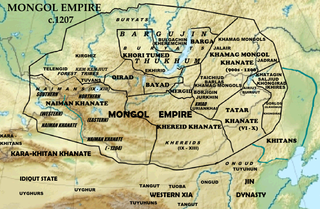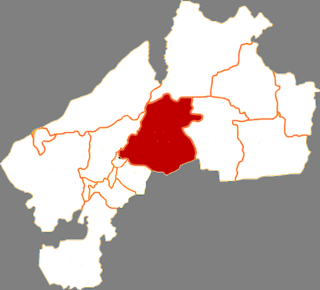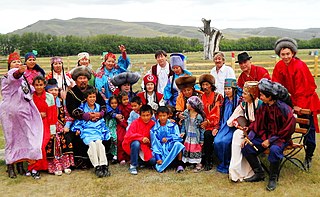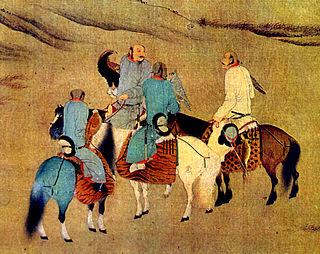
The Turkic languages are a language family of more than 35 documented languages, spoken by the Turkic peoples of Eurasia from Eastern Europe and Southern Europe to Central Asia, East Asia, North Asia (Siberia), and West Asia. The Turkic languages originated in a region of East Asia spanning from Mongolia to Northwest China, where Proto-Turkic is thought to have been spoken, from where they expanded to Central Asia and farther west during the first millennium. They are characterized as a dialect continuum.

The Turkic peoples are a collection of diverse ethnic groups of West, Central, East, and North Asia as well as parts of Europe, who speak Turkic languages.

Manchuria refers to a region in Northeast Asia encompassing the entirety of present-day Northeast China or, historically, those areas combined with parts of the Russian Far East which are often referred to as Outer Manchuria. Its definition may refer to varying geographical extents as following: the Chinese provinces of Heilongjiang, Jilin, and Liaoning but broadly also including the eastern Inner Mongolian prefectures of Hulunbuir, Hinggan, Tongliao, and Chifeng, collectively known as Northeast China. Historically included homeland of the Jurchens and later their descendants Manchus, which was controlled in whole by Qing China prior to the Amur Annexation in 1858–1860, when parts of the historical region were ceded to the Russian Empire. The two areas involved are Priamurye between the left bank of Amur River and the Stanovoy Range to the north; and Primorskaya which runs down the Pacific coast from the Amur Estuary to the Russo-Korean border, sometimes including the island of Sakhalin, collectively known as Outer Manchuria or Russian Manchuria.

The Kyrgyz people are a Turkic ethnic group native to Central Asia. They are primarily found in Kyrgyzstan, Uzbekistan, China, Pakistan and Afghanistan. A Kyrgyz diaspora is also found in Russia, Tajikistan, and Kazakhstan. They speak the Kyrgyz language, which is the official language of Kyrgyzstan.

The Tuvans or Tyvans are a Turkic ethnic group indigenous to Siberia who live in Russia (Tuva), Mongolia, and China. They speak Tuvan, a Siberian Turkic language. In Mongolia they are regarded as one of the Uriankhai peoples.

Northeast China is a geographical region of China, also called Manchuria in history. It usually corresponds specifically to the three provinces east of the Greater Khingan Range, namely Liaoning, Jilin, and Heilongjiang, but historically is meant to also encompass the four easternmost prefectures of Inner Mongolia west of the Greater Khingan. The heartland of the region is the Northeast China Plain, the largest plain in China, with an area of over 350,000 km2 (140,000 sq mi). It is separated from Russian Far East to the north by the Amur, Argun, and Ussuri Rivers; from Korea to the south by the Yalu and Tumen Rivers; and from Inner Mongolia to the west by the Greater Khingan and parts of the Xiliao River.

The Khakas are a Turkic indigenous people of Siberia, who live in the republic of Khakassia, Russia. They speak the Khakas language.
Fuyu Kyrgyz, also known as Manchurian Kirghiz, is a Turkic language, and as, Gïrgïs, Kyrgysdar is an ethnonym of the Turkic unrecognized ethnic group in China. Despite the name, the Fuyu Kyrgyz language is not closely related to the Kyrgyz language, which is of Kipchak origin. The Fuyu Kyrgyz language is more similar to the Western Yugur language and the Abakan Turkic languages. The people originated in the Yenisei region of Siberia but were relocated into Dzungaria by the Dzungars.

The Eurasian nomads were groups of nomadic peoples living throughout the Eurasian Steppe, who are largely known from frontier historical sources from Europe and Asia.

Khakas, also known as Xakas, is a Turkic language spoken by the Khakas, who mainly live in the southwestern Siberian Republic of Khakassia, in Russia. The Khakas number 73,000, of whom 42,000 speak the Khakas language. Most Khakas speakers are bilingual in Russian.
The Turkic migrations were the spread of Turkic tribes and Turkic languages across Eurasia between the 6th and 11th centuries. In the 6th century, the Göktürks overthrew the Rouran Khaganate in what is now Mongolia and expanded in all directions, spreading Turkic culture throughout the Eurasian steppes. Although Göktürk empires came to an end in the 8th century, they were succeeded by numerous Turkic empires such as the Uyghur Khaganate, Kara-Khanid Khanate, Khazars, and the Cumans. Some Turks eventually settled down into sedentary societies such as the Qocho and Ganzhou Uyghurs. The Seljuq dynasty settled in Anatolia starting in the 11th century, resulting in permanent Turkic settlement and presence there. Modern nations with large Turkic populations include Kyrgyzstan, Turkmenistan, Turkey, Azerbaijan, Uzbekistan and Kazakhstan, and Turkic populations also exist within other nations, such as Chuvashia, Bashkortostan, Tatarstan, Northern Cyprus, the Crimean Tatars, the Kazakhs in Mongolia, the Uyghurs in China, the Azeri in Iran, and the Sakha Republic in Siberia.

Tungusic peoples are an ethnolinguistic group formed by the speakers of Tungusic languages. They are native to Siberia, China, and Mongolia.

Uriankhai, Uriankhan or Uriankhat, is a term of address applied by the Mongols to a group of forest peoples of the North, who include the Turkic-speaking Tuvans and Yakuts, while sometimes it is also applied to the Mongolian-speaking Altai Uriankhai. The Uriankhai included the western forest Uriankhai tribe and the Transbaikal Uriankhai tribe, with the former recorded in Chinese sources as Chinese: 兀良哈; pinyin: Wùliánghā). It is the origin of the Korean term "barbarian", 오랑캐.

Nomadic empires, sometimes also called steppe empires, Central or Inner Asian empires, were the empires erected by the bow-wielding, horse-riding, nomadic people in the Eurasian Steppe, from classical antiquity (Scythia) to the early modern era (Dzungars). They are the most prominent example of non-sedentary polities.

Fuyu is a county of western Heilongjiang province, China, under the administration of Qiqihar City, the downtown of which is 65 kilometres (40 mi) to the southwest. Various economic crops and the milk are produced in the fertile land. The county has an area of 4,335 square kilometres (1,674 sq mi), and a population of 300,000 inhabitants.

The Yenisei Kyrgyz, were an ancient Turkic people who dwelled along the upper Yenisei River in the southern portion of the Minusinsk Depression from the 3rd century BCE to the 13th century CE. The heart of their homeland was the forested Tannu-Ola mountain range, in modern-day Tuva, just north of Mongolia. The Sayan mountains were also included in their territory at different times. The Yenisei Kyrgyz Khaganate existed from 538 to 1219 CE; in 840, it took over the leadership of the Turkic Khaganate from the Uyghurs, expanding the state from the Yenisei territories into Central Asia and the Tarim Basin.

The Khitan people were a historical nomadic people from Northeast Asia who, from the 4th century, inhabited an area corresponding to parts of modern Mongolia, Northeast China and the Russian Far East.
Kyrgyz, Kirghiz or Kyrgyzstani may refer to:













